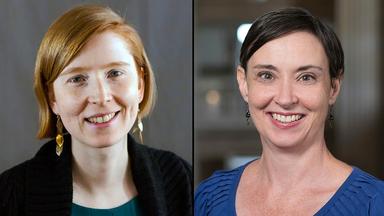by Drake Lawrence
On occasion, the Humphrey School of Public Affairs highlights stories of innovation from government offices around the state of Minnesota and the Native nations that share its geography. Here we highlight the efforts of the Minnesota Department of Human Services’ Behavioral Health Division in treating nicotine addiction at its residential treatment facilities.
Public health officials have long worked to address the devastating public and individual effects of illegal and legal drug use and tobacco use, but often those efforts are done separately.
Treatments for tobacco use have been considered secondary, and less imperative to treating the addiction that leads someone with substance use disorder (SUD) to one of the 130 residential treatment facilities in the state of Minnesota.
But the work of the Minnesota Department of Human Services’ Behavioral Health Division (BHD) aims to change that. The BHD implemented a pilot program in 2018 to reduce nicotine use among its clients. The pilot program made clear that to continue updating how residential facilities treat nicotine addiction, a culture shift was needed.
The Pilot Program
In 2018 the Department of Human Services launched a pilot program at residential facilities in the metro area and St. Cloud, encouraging them to implement evidence-based nicotine treatment/cessation programming in conjunction with SUD treatment.
“The thing that struck me, 70 percent of people coming into treatment wanted to quit smoking,” said Randy McCallum, Nicotine Policy Program manager at DHS. The program allowed DHS to begin the process of engaging with residential treatment facilities to encourage nicotine treatment, a vital component in the health of those seeking support.
As Collin Frazier, supervisor of the Nicotine Treatment, Point of Sale Prevention and Control Section at the BHD noted, nicotine use is statistically more likely to kill a user than the substance for which individuals are in treatment, and to not offer comprehensive support is a failing in the system.
The pilot program, then, brought out a need for cultural change. And that work requires a great deal of innovation.
Encouraging cultural shifts, correcting biases, and unpacking the myths that have dictated past decisions are particularly difficult hurdles to clear for government redesign. It requires facts and support. It requires a commitment by staff that is often difficult to fund. And it requires buy-in from those who are truly doing the work.
The efforts of the Behavioral Health Division are far from complete, but it’s working now to accomplish these steps.
Facts and Support
Through the pilot program, the BHD heard direct input from on-site counselors and conducted important research on the state of nicotine treatment programs in residential facilities.
Surveys showed a significant majority of nicotine users in SUD treatment programs wanted to quit and saw it as important for their overall health. But of the treatment facilities that assessed for nicotine dependence, 40 percent did not offer specific intervention in their treatment programs; 60 percent didn’t offer group counseling; and 30 percent didn’t offer individual counseling.
With this information, and insight from counselors and specialists, BHD staff continued the work after the pilot program’s conclusion to reconfigure how facility staff approach nicotine treatments.
Commitment of Staff
In April 2019, Nicotine Policy Program Manager Randy McCallum began the full-time task of advocating and educating facility staff on nicotine treatment programs. McCallum, an alcohol and drug counselor, describes his role as “the boots-on-the-ground advocate” for training treatment staff to incorporate nicotine treatment programming. “I like to call it laying the foundation,” he said.
His work and the work of other BHD staff has yielded advocates in many facilities: Nurses who strongly believe the changes are necessary; counselors who buy into cessation programs and other methods of support. These trainings are seeing results in encouraging more staff to support nicotine treatment programs and offer their expertise and insights.
Buy-In
The commitment of staff at residential facilities around the state is ongoing. Frazier said many of the challenges lie in a long and complicated history.
“Historically, some programs offered cigarettes to clients as incentives. Some counselors would say they get more treatment done during a smoke break with a client than they would during the session,” Frazier said. “Some programs included (and still include) cigarettes in the approved items a client could bring to residential treatment, along with their toothbrush. Some staff still believe we should not be treating tobacco/nicotine dependence because it takes away from the [client’s] real needs.”
Nicotine use is statistically more likely to kill a user than the substance for which the individual is in treatment, and to not offer comprehensive support is a failing in the system. ~ Collin Frazier
In a field that has difficulties with turnover and burnout, bringing treatment staff into this culture shift requires tact and a mind for that history.
“In the past, staff may have been uncomfortable addressing tobacco use if they themselves were tobacco users,” said McCallum. So part of the culture shift is getting staff to understand the ethical responsibility of addressing commercial tobacco use, whether or not they use tobacco themselves.
“If you’re a counselor who smokes, you still have information to give,” said McCallum, noting that a person-centered approach to the client means that a counselor’s personal tobacco use won’t impact the client’s ability to receive nicotine treatment.
Culture is not easily changed. But as training programs are continuing throughout the state, the Department of Human Services Behavioral Health Division is bringing more folks into this effort. McCallum hopes to expand that training to the schools that are preparing the next generation of counselors and treatment staff.
BHD is offering new grants with hopes of providing nicotine treatment support and training to more residential facilities, especially those whose client base draws more heavily from communities that tend to have higher nicotine use yet limited access to treatment, such as American Indian, Black, veterans and LGBTQ populations. The BHD is also working to establish a learning community of facility staff who can share best practices.
All of these steps are underway in order to care more fully for those who require substance use disorder treatment.
“We’re trying to set a critical mass of support,” Frazier said. “Nineteen states and more than 500 cities raised the age to purchase tobacco to 21 before Congress finally raised the federal minimum age, so it takes enough folks to buy in and create small changes before we see systemwide change.”


